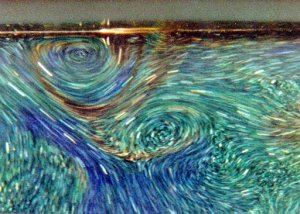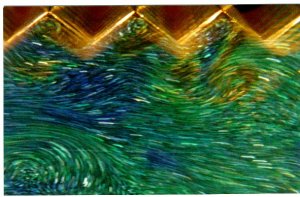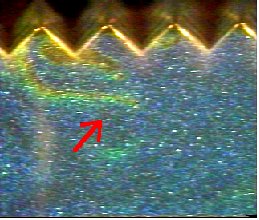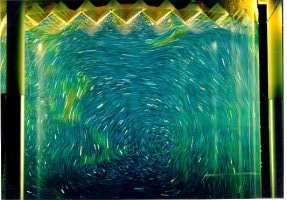Turbulent Thermal Convection over a Rough Surface
Yibing Du and Penger Tong
Department of Physics, Oklahoma State University
- Winning poster at the Gallery of Fluid Motion in the 52nd Annual Meeting of The American Physical Society's Division of Fluid Dynamics, Nov. 21-23, 1999, New Orleans, Louisiana.

A novel convection experiment was conducted in a cylindrical cell filled with water. Two identical aspect-ratio-one cells, one has smooth upper and lower surfaces and the other has rough upper and lower surfaces are made for comparison. The rough surfaces are made from identical brass plates but have woven V-shaped grooves on them. The spacing between the grooves is such that a square lattice of pyramids of height 9 mm is formed on the surface. The cell is uniformly heated from below and cooled on the top. The heat transport across the rough cell is found to be increased by more than 76% when compared with the smooth cell [Phys. Rev. Lett. 81, 987 (1998)]. To find the real mechanism for the enhanced heat transport, we use a photographic technique to visualize the temperature and velocity fields near the upper surface. With this technique, small thermochromic liquid crystal (TLC) spheres are seeded in the fluid.

The Bragg-scattered light of the TLC spheres changes color from red to blue in a narrow temperature range. A long exposure time of 0.5s is used to take streak pictures of the TLC spheres, in which cooler regions of the fluid appear brown and warmer regions appear green and blue. The top and middle pictures on the left show how a thermal plume is erupted from the (upper) cold smooth and rough surfaces, respectively, at the Rayleigh number 2.6 �109. The emission dynamics of the thermal plumes in the smooth cell differs greatly from that in the rough cell. In the smooth cell, the plume is erupted by its own buoyancy, which accelerates the fluid in the central stem of the plume. The sudden acceleration of the fluid produces a vortex ring around the stem, which gives the characteristic mushroom shape of the thermal plume. A 2D projection of the vortex ring shows a pair of vortices with opposite signs. In the rough cell, however, we find that the large-scale motion in the near-wall region, which is well characterized by a simple shear flow (from right to left), is modulated by the rough surface, a situation very much like a steady flow passing over bluff obstacles on a wall. The mean flow is forced to become divergent from the surface when it meets with the upstream side of a pyramid. On the downstream side of the pyramid, an adverse pressure gradient is formed inside the groove region. This pressure gradient produces an eddy whose vorticity component is in the transverse direction of the mean flow and its sign is opposite to that of the large-scale circulation. The interaction between the upstream divergent flow and the downstream back flow causes the thermal boundary layer to detach near the tip of the pyramid (see the sketch below).

Because the detachment of the boundary layer is driven by the large-scale flow, instead of the buoyancy force, the vortex ring generated by the buoyancy acceleration disappears and thus the thermal plumes in the rough cell lose their mushroom cap. Occasionally, we do see a few mushroom-shaped plumes in the rough cell, such as that shown in the bottom picture on the left, but the majority of the thermal plumes looks like that shown in the middle picture. Our experiment reveals that the interaction between the horizontal shear flow and the eddies trapped inside the groove region enhances the detachment of the thermal plumes. These extra thermal plumes are responsible for the enhanced heat transport found in the rough cell.

- The eruption process of a thermal plume (pointed by a red arrow) near the smooth and rough surfaces.







- Large-scale circulation in turbulent thermal convection in the smooth and rough cells.

